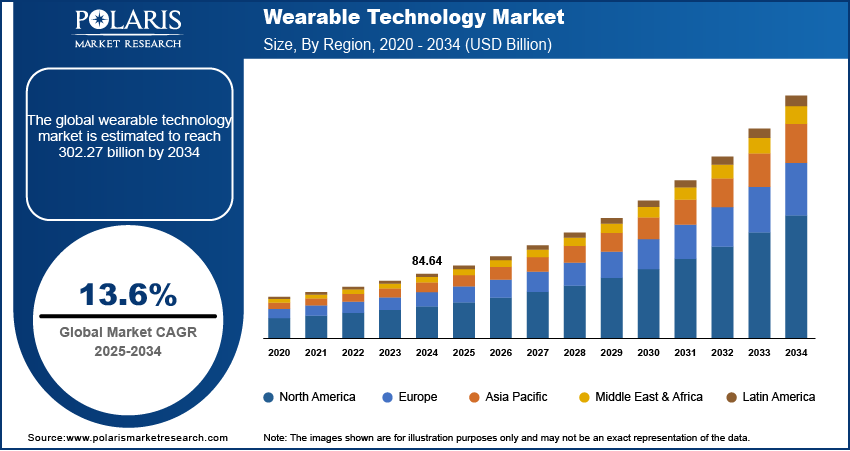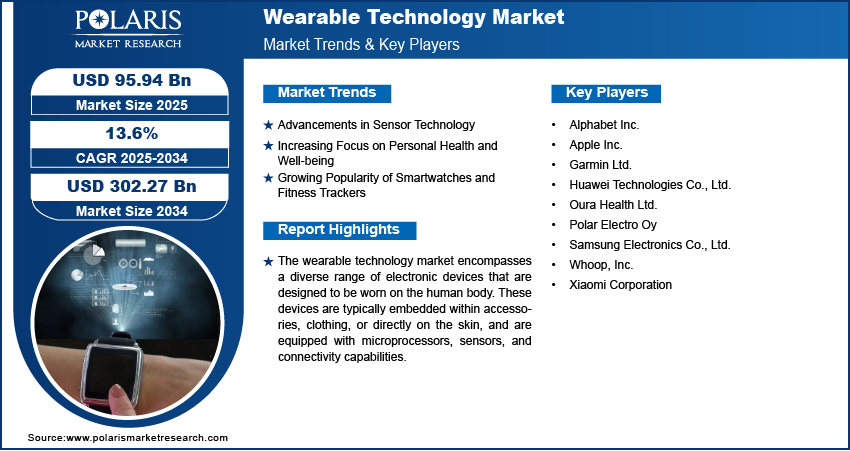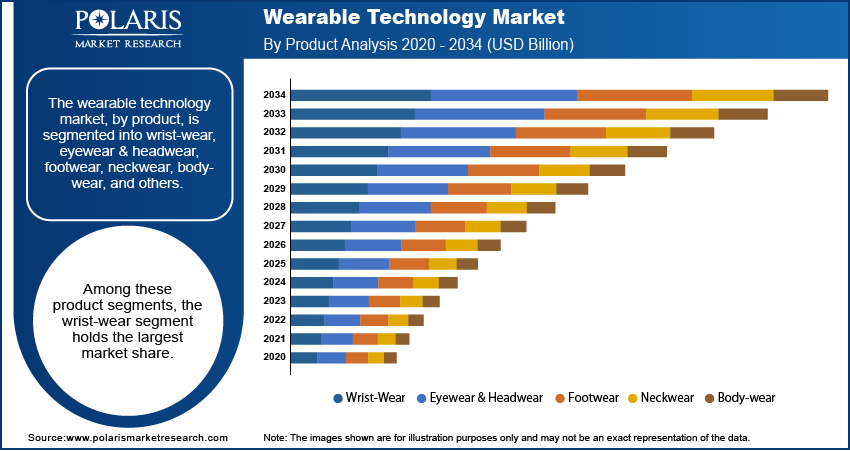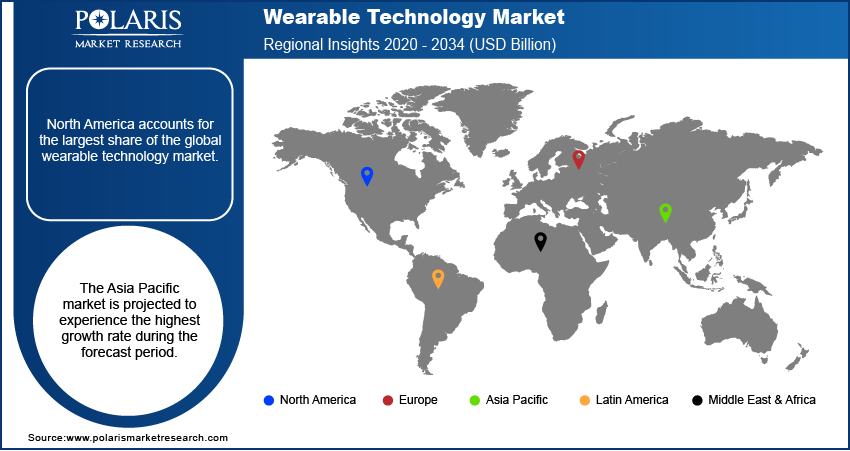
Wearable Technology Market Size, Share, Trends, Industry Analysis Report
: By Product (Wrist-Wear, Eyewear & Headwear, Footwear, Neckwear, Body-Wear, and Others), Application, and Region (North America, Europe, Asia Pacific, Latin America, and Middle East & Africa) – Market Forecast, 2025–2034
- Published Date:Sep-2025
- Pages: 120
- Format: PDF
- Report ID: PM2894
- Base Year: 2024
- Historical Data: 2020-2023
Market Overview
The wearable technology market size was valued at USD 84.64 billion in 2024 exhibiting a CAGR of 13.6% during 2025–2034. The market has seen substantial growth, driven by increasing consumer interest in health and fitness tracking, advancements in miniaturization and sensor technology, and the rising market demand for convenient and connected devices.
Key Insights
- The Wrist-wear segment dominates the market due to increasing demand for smartwatches and fitness trackers offering multifunctional features such as health tracking and smooth integration with smartphones.
- The most growth will come from the healthcare application segment, driven by the increasing use of wearable devices for remote patient monitoring, chronic disease management, and preventive care.
- North America leads the wearable technology market owing to high disposable incomes, robust technological infrastructure, and early adoption of advanced electronic devices.
- The market in Asia Pacific is expected to grow the most due to a large, expanding consumer base, increased disposable incomes, and rising awareness of health and fitness trends.
Industry Dynamics
- The increasing utilization of advanced sensors facilitates more accurate and comprehensive monitoring of health parameters, which increases market demand.
- Advances in sensor technology are powering the market by allowing devices to track a broad array of health and environmental information with greater precision.
- This increasing demand is fueled by a rising worldwide concern for individual health, with customers using products such as smartwatches and fitness trackers to monitor and maintain their well-being actively.
- One of the main constraints for the wearables market is that complex devices are expensive, and this could hold them back among price-conscious consumers and decelerate mass-market take-up.
Market Statistics
- 2024 Market Size: USD 84.64 billion
- 2034 Projected Market Size: USD 302.27 billion
- CAGR (2025-2034): 13.6%
- North America: Largest Market Share
AI Impact on Wearable Technology Market
- AI improves wearables by allowing for more intelligent, more personalized user experiences.
- It enables wearables to process real-time data and supply actionable insights for health, fitness, and well-being.
- Algorithms powered by AI enhance the precision of health tracking, including heart rate, sleep, and stress.
- AI allows wearables to learn about each person's behavior and proactively suggest improved habits.
- It also supports building predictive attributes, including identifying precursors to health problems when they are not yet severe.

To Understand More About this Research: Request a Free Sample Report
The wearable technology market encompasses electronic devices designed to be worn on the body, often integrated into accessories, clothing, or even implanted or tattooed onto the skin. These devices are typically equipped with microprocessors and connectivity capabilities, forming a significant part of the Internet of Things (IoT). The primary function of wearable technology is to detect, analyze, and transmit data related to the wearer, such as vital signs, activity levels, and ambient data, often providing immediate biofeedback. This market growth is fueled by the expanding applications of wearable technology beyond consumer electronics into healthcare, enterprise, and defense sectors, highlighting the vast market potential.
A key wearable technology market growth is driven by the rising awareness and focus on personal health and well-being, leading to greater adoption of wearable health monitoring devices. The increasing integration of advanced sensors allows for more accurate and comprehensive tracking of health metrics, driving market demand. Furthermore, the growing popularity of smartwatches and fitness trackers, coupled with advancements in industry trends such as flexible displays and longer battery life, enhances market penetration. The market development is also supported by the continuous innovation in features and functionalities, making these devices increasingly indispensable for a wide range of users. For companies considering market entry assessments, the robust market forecast and promising market stats indicate a sector with significant growth opportunities. The market dynamics are characterized by constant technological evolution and a growing consumer base seeking seamless integration of technology into their daily lives.
Market Dynamics
Advancements in Sensor Technology
The continuous advancements in sensor technology are fueling the wearable technology market development. Wearable devices increasingly incorporate sophisticated sensors capable of monitoring a wide array of physiological and environmental data with greater accuracy and reliability. For instance, a research article published in RSC Advances in 2025 highlights recent progress in flexible sensor designs and their integration with machine learning for enhanced human-machine interaction. The study emphasizes how innovations in sensor materials and data processing are enabling wearable electronics to achieve high performance and provide intelligent real-time responsiveness. This evolution from basic motion sensors to integrated systems, including pressure sensors, gyroscopes, temperature sensors, humidity detectors, and increasingly sophisticated heart rate monitors, as noted in a 2023 article by Renesas, allows for a more comprehensive understanding of the wearer's health and activity.
Increasing Focus on Personal Health and Well-being
The wearable technology market demand is growing owing to the rising global emphasis on personal health and well-being. Individuals are increasingly proactive in monitoring their health metrics, tracking fitness activities, and adopting healthier lifestyles. Wearable devices, such as smartwatches and fitness trackers, provide a convenient and continuous way to collect and analyze this data. Around 2 in 5 US/UK smartwatch/fitness tracker owners say their device helps them feel more in control of their health and proactively manage their well-being.
According to UCLA Health, in an article published in 2025, wearable technology assists users in various aspects of health management, including tracking physical activity, monitoring heart health, optimizing workouts, and even detecting falls. The ability of these devices to provide personalized health snapshots and potentially aid in the early detection of medical issues is a significant market driver.

Segment Insights
Market Assessment – By Product
The market, by product, is segmented into wrist-wear, eyewear & headwear, footwear, neckwear, body-wear, and others. The wrist-wear segment holds the largest market share. This dominance can be attributed to the widespread adoption of smartwatches and fitness equipment and trackers, which offer a versatile range of functionalities from health monitoring and communication to seamless integration with smartphones. The convenience and utility of wrist-worn devices have made them a popular choice among consumers globally, establishing a strong market presence. The continuous innovation in features, design, and affordability further solidifies the leading position of the wrist-wear segment within the broader wearable technology market, influencing overall market dynamics.
The eyewear & headwear segment is exhibiting the highest market growth rate. This rapid expansion is fueled by advancements in augmented reality (AR) and virtual reality (VR) in healthcare technologies, leading to the development of increasingly sophisticated smart glasses and head-mounted displays. These devices are finding applications across various sectors, including gaming, enterprise, healthcare, and training, indicating significant market potential. The ongoing research and development in miniaturization, display technology, and user interface are expected to further enhance the capabilities and appeal of eyewear & headwear, driving substantial market development and contributing significantly to future market trends.
Market Evaluation– By Application
The market, by application, is segmented into consumer electronics, healthcare, enterprise & industrial applications, and others. The consumer electronics segment dominates the wearable technology market share. This is primarily driven by the high adoption rates of smartwatches, fitness trackers, and other wearable devices used for personal entertainment, communication, and fitness tracking. The widespread consumer appeal, coupled with continuous product innovation and decreasing average selling prices, has established a significant market presence for wearable technology within the consumer electronics sector. This substantial market demand from individual users makes it the dominant application area within the market.
The healthcare application segment is anticipated to exhibit the highest market growth rate. This rapid expansion is fueled by the increasing integration of wearable devices for remote monitoring and control, chronic disease management, and preventative care. The growing emphasis on personalized healthcare solutions and the potential of wearables to improve patient outcomes and reduce healthcare costs are significant market growth factors. Furthermore, advancements in sensor technology and data analytics are enabling the development of more sophisticated medical-grade wearable devices, indicating substantial market potential and driving significant market development.

Regional Analysis
A comprehensive regional analysis reveals a global landscape with varying levels of adoption and growth across different geographies. North America, Europe, Asia Pacific, Latin America, and the Middle East & Africa each present unique market dynamics influenced by factors such as technological infrastructure, consumer preferences, healthcare regulations, and economic development. While some regions currently exhibit higher market penetration, others are poised for more rapid expansion, reflecting diverse market potential and evolving market trends on a worldwide scale. Understanding these regional nuances is crucial for companies formulating market entry assessments and aiming to capitalize on the global market development of wearable technology.
North America accounts for the largest share of the wearable technology market revenue. This dominance is primarily attributed to the region's high disposable income, strong technological infrastructure, and early adoption of advanced electronic devices. Furthermore, a significant focus on health and wellness, coupled with the presence of major technology players and robust healthcare systems, fuels substantial market demand for wearable devices in this region. The well-established market drive and mature consumer electronics market contribute to North America's leading position in terms of overall market size and adoption of various wearable products, influencing global market outlook.
The Asia Pacific wearable technology market is projected to experience the highest growth rate during the forecast period. This rapid expansion is driven by a large and rapidly growing consumer base, increasing disposable incomes, and a rising awareness of health and fitness trends. Furthermore, the proliferation of smartphones and increasing internet penetration in many Asia Pacific countries create a favorable environment for the adoption of connected wearable devices. The region's burgeoning technological advancements, coupled with supportive government initiatives promoting digital health and technological innovation, indicate significant market potential and are expected to contribute substantially to the future market development.

Key Players and Competitive Insights
A few key major players currently active in the wearable technology market include Apple Inc.; Samsung Electronics Co., Ltd.; Alphabet Inc. (Fitbit LLC); Garmin Ltd.; Xiaomi Corporation; Huawei Technologies Co., Ltd.; Polar Electro Oy; Oura Health Ltd.; and Whoop, Inc. These companies offer a diverse range of wearable products, including smartwatches, fitness trackers, smart eyewear, and other body-worn devices, catering to various consumer needs and preferences within the market.
Competitive analysis of the wearable technology market reveals a dynamic landscape characterized by intense rivalry among numerous players. Competition is driven by factors such as product innovation, feature differentiation, pricing strategies, brand recognition, and distribution channels. Companies are continuously investing in research and development to introduce new functionalities, improve user experience, and expand their product portfolios. Strategic partnerships, collaborations, and acquisitions also play a significant role in shaping the competitive environment. Understanding the market share and market penetration of these players provides valuable market insights into the current market dynamics and future market trends.
Apple Inc. is headquartered in Cupertino, California, US. Their offerings in the wearable technology market primarily include the Apple Watch, a popular smartwatch known for its health and fitness tracking capabilities, seamless integration with the Apple ecosystem, and a wide array of applications. The Apple Watch maintains a significant presence in the wrist-wear segment, making Apple a relevant player in driving market demand and shaping industry trends.
Garmin Ltd. is located in Schaffhausen, Switzerland. The company provides a broad spectrum of wearable devices, including smartwatches, fitness trackers, and specialized wearables for running, cycling, and outdoor activities. Garmin's products are recognized for their robust build quality, accurate GPS tracking, and focus on detailed performance metrics, catering to both casual users and serious athletes, thus contributing significantly to the market size and market development of the market.
List of Key Companies
- Alphabet Inc. (Google Pixel Watch)
- Apple Inc.
- Garmin Ltd.
- Huawei Technologies Co., Ltd.
- Oura Health Ltd.
- Polar Electro Oy
- Samsung Electronics Co., Ltd.
- Whoop, Inc.
- Xiaomi Corporation
Wearable Technology Industry Developments
- December 2024: SAMSUNG (South Korea) partnered with Cheil (South Korea) India and TVF to launch the Galaxy A16 5G. The collaboration leverages TVF’s storytelling expertise to integrate the device into relatable daily scenarios, targeting users in tier-2 and tier-3 towns. The campaign highlights the device's advanced features, affordability, and relevance across India.
- November 2024: CardioComm Solutions (US) partnered with Sony Group Corporation (Japan) to integrate its ECG technology into the mSafety platform. This collaboration enables users to monitor their heart health through a wearable device without needing a smartphone. The integration supports early detection of heart issues, post-hospital discharge monitoring, and pharmaceutical trials.
Wearable Technology Market Segmentation
By Product Outlook (Revenue-USD Billion, 2020–2034)
- Wrist-Wear
- Eyewear & Headwear
- Footwear
- Neckwear
- Body-Wear
- Others
By Application Outlook (Revenue-USD Billion, 2020–2034)
- Consumer Electronics
- Healthcare
- Enterprise & Industrial Applications
- Others
By Regional Outlook (Revenue-USD Billion, 2020–2034)
- North America
- US
- Canada
- Europe
- Germany
- France
- UK
- Italy
- Spain
- Netherlands
- Russia
- Rest of Europe
- Asia Pacific
- China
- Japan
- India
- Malaysia
- South Korea
- Indonesia
- Australia
- Vietnam
- Rest of Asia Pacific
- Middle East & Africa
- Saudi Arabia
- UAE
- Israel
- South Africa
- Rest of the Middle East & Africa
- Latin America
- Mexico
- Brazil
- Argentina
- Rest of Latin America
Wearable Technology Market Report Scope
|
Report Attributes |
Details |
|
Market Size Value in 2024 |
USD 84.64 billion |
|
Market Size Value in 2025 |
USD 95.94 billion |
|
Revenue Forecast by 2034 |
USD 302.27 billion |
|
CAGR |
13.6% from 2025 to 2034 |
|
Base Year |
2024 |
|
Historical Data |
2020–2023 |
|
Forecast Period |
2025–2034 |
|
Quantitative Units |
Revenue in USD billion and CAGR from 2025 to 2034 |
|
Report Coverage |
Revenue Forecast, Market Competitive Landscape, Growth Factors, and Industry Insights |
|
Segments Covered |
|
|
Regional Scope |
|
|
Competitive Landscape |
|
|
Report Format |
|
|
Customization |
Report customization as per your requirements with respect to countries, regions, and segmentation. |
How is the report valuable for an organization?
Workflow/Innovation Strategy
The wearable technology market has been segmented on the basis of product and application. Moreover, the study provides the reader with a detailed understanding of the different segments at both the global and regional levels.
Market Entry Strategies
Growth and marketing strategies within the market are multifaceted, focusing on continuous innovation in product features and functionalities to meet evolving consumer needs and market demand trends. Companies are increasingly emphasizing health and wellness applications, leveraging advanced sensors and data analytics to provide personalized insights and drive market growth factors. Strategic collaborations with healthcare providers and fitness platforms are also key to expanding market penetration. Effective marketing campaigns highlight the convenience, style, and health benefits of wearable devices, targeting specific consumer segments and leveraging digital channels for broader reach.
FAQ's
The market size was valued at USD 84.64 billion in 2024 and is projected to grow to USD 302.27 billion by 2034.
The market is projected to register a CAGR of 14.2% during the forecast period.
North America held the largest share of the market in 2024.
A few key players in the market include Apple Inc.; Samsung Electronics Co., Ltd.; Alphabet Inc. (Fitbit LLC); Garmin Ltd.; Xiaomi Corporation; Huawei Technologies Co., Ltd.; Polar Electro Oy; Oura Health Ltd.; and Whoop, Inc..
The wrist-wear segment accounted for the largest share of the market in 2024.
Following are a few of the market trends: ? Advanced Health Monitoring: Wearables are increasingly incorporating sophisticated sensors for continuous and more accurate tracking of vital signs such as ECG, blood oxygen levels, glucose monitoring (in some advanced devices), and sleep analysis, catering to the growing health consciousness among users. ? Integration of AI and Machine Learning: Artificial intelligence is being embedded in wearable devices to provide personalized insights, predictive health alerts, and enhance user interaction through features such as health scoring and conversational virtual assistants. ? Growth of Smartwatches and Smart Rings: Smartwatches continue to be a major driving force with innovations in health tracking, connectivity, and AI, while smart rings are gaining traction due to their discreet design and health-tracking capabilities.
Wearable technology refers to electronic devices that can be worn on the body, often integrated into clothing, accessories, or even directly on the skin. These devices are equipped with sensors, software, and connectivity, allowing them to collect, analyze, and transmit data related to the wearer's health, activity levels, and environment. Examples of wearable technology include smartwatches, fitness trackers, smart glasses, smart jewelry, and even smart clothing. Their primary function is to provide users with convenient access to information and enhance their daily lives through features such as health monitoring, communication, entertainment, and more.
